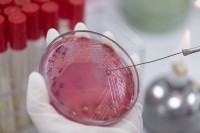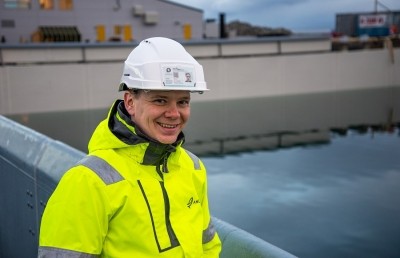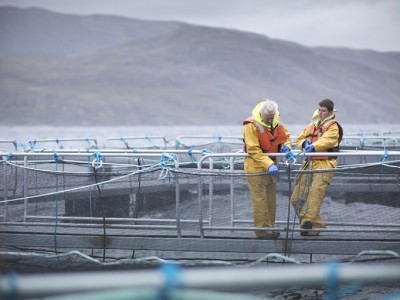Nutreco sets out bold new sustainability strategy

This five-year strategy, called RoadMap 2025, includes Nutreco's pledges under the Science Based Target Initiative (SBTi), which commits to review, accept, and publish the group’s reduction targets in Q1 2021.
The company said it embraces the objective of the Paris Agreement, to limit global temperature rises to well below 2°C and aims to contribute to the UN Sustainable Development Goals (SDGs).
The new RoadMap 2025 sets out renewed and measurable targets, including efforts to reduce antimicrobial resistance (AMR) and an overall reduction of the company’s carbon footprint. It also establishes broader corporate citizenship goals, including moving the dial on diversity by ensuring a quarter of its leadership positions are held by women.
Nutreco outlined how the strategy is underpinned by three key pillars of health and welfare, climate and circularity, and good citizenship; it will be executed through its premix and feed additives division, Trouw Nutrition, and its aquaculture arm, Skretting.
“With RoadMap 2025, we have a clear dot on the horizon,” Nutreco sustainability director José Villalón, told us.
“That is our sustainability strategy for the next five years through to December 2025, we are really happy about it. It was a grassroots process, we involved not only our staff, from the bottom up, but external stakeholders as well.”
Nutreco now has a strong platform to take a leadership position in some areas such as soy and palm oil sourcing and a “very good” position in other areas. “As a global company it is challenging to lead on all the key issues,” he acknowledged.
There are a lot of issues in sustainability, he continued, whereby it is much more effective to move the whole industry together in the same direction. “Pre-competitive, multi-stakeholder type platforms are crucial for the big issues likes deforestation, child labor, or slave labor in the fishing industry. With those particular issues, we play a role, and we try to play an influential role, we try to participate at the steering committee level, the leadership committees, in these platforms, to help influence the conversation.”
Tackling soy linked deforestation head-on
Deforestation, both legal and illegal, is a major environmental challenge in sensitive geographies and biomes. “Nutreco remains committed to tackling this issue, even when, after eight years, the solution has [eluded] us from an industrial level perspective. RoadMap 2025 sets a clear target on deforestation and we will achieve those targets by December 2025. We are getting our global business to adhere to that timescale for our practical procurement policy, which was outlined last December,” commented Villalón.
That policy, he said, is a four-step process, which starts by the company conducting a risk-map assessment to filter countries of origination for their deforestation risk. “If deforestation risk does not exist in an area, then our buyers can buy at will from that region without further action.”
If there is a deforestation risk, then step two sees the company’s purchasing team only buying soy from that region that is compliant with the FEFAC soy sourcing guidelines. The third step sees the company only buying soy sourced from high risk areas that is compliant with any of the six soy standards outlined in the Profundo report, financed by the ICUN.
“Steps one to three are going to be accomplished at various speeds depending on the variety of the business environment and where we are operating in. But the fourth phase of the policy will ensure that, by 2025, all soy from risk geographies will be sourced as RTRS or ProTerra compliant, certified and segregated.”
Preservation of the Cerrado
By that deadline also, the company is pushing to have biome-wide assurance in specific high-risk geographies such as the Cerrado, in Brazil. “That biome-wide assurance work, which we are doing right now, may be designed around the payment for environmental services concept, [a financial incentive program], and this target is really consistent with the work Nutreco is involved in as a steering committee member and a founding signatory of the Statement of Support to the Cerrado.”
Nutreco was also one of three companies in 2019 that, along with UK retailer, Tesco, and Norwegian company, Grieg Seafood, committed to backing the Cerrado Funding Coalition, a fund to reward farmers who can preserve native vegetation on their soy farms in the Cerrado region.
The idea of setting up such a fund had long been a point of discussion among industry stakeholders and international actors. This mechanism, however, has hit a few roadblocks on the ground.
“Abiove, the Brazilian soy producer association, walked away from some of those discussions in December 2019. We are still conversing with them. They have a new chairman, who we are re-engaging with as to explore how we can start incorporating this financial mechanism.”
There are political sensitivities to be taken account of and a player like Nutreco is very aware of those, he remarked. ”A country has its sovereign right; if you are a landowner in Brazil, and you have bought land to make a living for your family, who are we to say you can’t touch that land, you can’t convert it. This payment for environmental services concept is the evolution of a moratorium. This is a great approach that gives that landowner an income, while the native vegetation on their land is preserved in the process.
“Hopefully, if we can get that off the table, that, and our pragmatic stepwise program, will culminate in Nutreco and its products being completely decoupled from the negative impacts of biodiversity loss and climate change associated with deforestation in our value chain. It is within the grasp of our industry sector.”
Transparency, traceability
Villalón thinks one of the real opportunities for the food value chain is to focus on transparency and traceability. “Throughout the COVID-19 pandemic, we have seen that people are more interested and increasingly focused on how and where their food was produced. The consumer is beginning to ask those questions. I think the food value chain is perfectly poised to start offering more transparency and traceability so that the consumer, either at food retail or at foodservice level, when it opens up again, will know what went into the food and how it was produced.”
He said the consumer also wants communication about and guarantees from the food value chain on issues such as deforestation or slave labor, and antibiotic use. “We have got to deliver on that.”
The shift away from fossil fuels
In addition to its ambitions on deforestation, Nutreco has Science-Based Targets (SBT) for GHG emission reductions, matched by a set of carbon footprint tools; the group has set out targets in its RoadMap to significantly reduce energy usage.
By 2025, it aims to consume less than 2% of its energy from coal and less than 5% of its energy from fuel oil. By 2030, it wants to be completely coal-free and fuel oil-free.
“In Nutreco’s total C02 emissions for 2020, coal accounted for 7% and fuel oil accounted for 20%,” said Villalón.
The company plans to reduce its carbon footprint by enacting energy efficiency initiatives in all its facilities, by sourcing more renewable, or green electricity, by placing solar panels on roofs of facilities where it is relevant, and by engaging in power purchase agreements (PPA), which are longer term contracts with renewable energy as their source, he explained.
Can those targets be achieved, are they realistic?
“The RoadMap 2025 is challenging, it is ambitious, but it is realistic. It would be really difficult in Nutreco to get something that is not realistic through the board.”
Reducing antimicrobial resistance
Antimicrobial resistance (AMR) is another key issue for Nutreco and one that is now targeted as per the RoadMap 2025
Its report cited the UN Ad hoc Interagency Coordinating Group on Antimicrobial Resistance, which states that if no action is taken, drug-resistant diseases could cause 10 million deaths each year by 2050 and damage to the economy as catastrophic as the 2008-2009 global financial crisis.
By 2030, AMR could force up to 24 million people into extreme poverty, it added.
Nutreco has never before had a comprehensive and strategic policy on AMR. Most of its past activity around this human health challenge was in raising awareness and making “calls to action” at public speaking events and pre-competitive platforms.
Looking towards 2025, its strategy outlines how AMR is an area the company will address.
“Nutreco plays an influential role in the food value chain and we are convinced that with early and proper animal nutrition, with functional feed additives for healthy guts, and a holistic approach to best practice and animal husbandry protocols, we can help our animal producer clients around the world – in poultry, pork, beef or dairy, fish or shrimp, to reduce their dependency on antibiotic usage,” said Villalón.
But Nutreco firmly believes, he continued, that if an animal gets sick, it has an welfare right to receive medicinal therapy, through responsible application of those drugs, and only with veterinary supervision.
The premix and feed group’s report outlines how it will look to innovating new products and services that will directly reduce dependency on antibiotic usage in animal husbandry. It will also work with other industry members and legislators in this respect.
Novel ingredient usage
The target for the use of novel ingredients in its products in RoadMap 2025 is between 5% and 10% to 2025.
This goal is not only limited to Nutreco feeds, but also the vehicle (filler) in its premix business. Nutreco defines novel ingredients as ‘unconventional feed ingredients from plant, animal and inorganic origins (not traditionally used by feed manufacturers), where after extensive R&D work and volume scale up, can be used as suitable alternatives for conventional ingredients in commercially relevant quantities.’
“Nutreco’s Roadmap 2025 target is quite challenging because a 5% inclusion rate in our product portfolio represents almost 400,000MT of novel ingredients by December 2025. Today, there isn’t a quarter of that volume even close to being available on the market. In addition, today, some of the novel ingredients offered are at a price multiple of the conventional commodity ingredient that they are designed to replace with variable and sometimes only marginal improvement in their carbon footprint. That equation will not work well in the animal and aqua feed industry,” commented Villalón.
RoadMap 2025, he said, sends a clear message and call to action for novel ingredient manufacturers, that Nutreco is open-for-business and accepts its role in reducing the greenhouse gas footprint of its products, but it is a two-way street. “We need you to work with us in offering [ingredients] at reasonable and competitive prices.”
The company recognizes that the novel ingredient industry has only got underway in earnest in the last decade or so and there is the current reality of scalability and low volumes, he said. The reality is that the feed industry needs all the viable ingredients that it can get at realistic costs to reduce its dependency on the typical commodity ingredients such as wheat, corn, fishmeal and soybean meals, and their derivatives, and to ultimately reduce the carbon footprint and other environmental impacts of its products, he added.
“That is the real goal of utilizing novel ingredients, to reduce our carbon footprint and validate that reduction through Life Cycle Assessment (LCA) methodology. The client should have this information readily available and should demand of their feed supplier, whomever that may be, to demonstrate how their products are helping them reduce their carbon footprint. Only in that way will we start seeing climate change mitigation in our industry.”
Sustainable packaging targets
Packaging is also part of the company’s RoadMap 2025.
Hurdles still exist for the industrial scale sustainable packaging sector for commoditized ingredients, though, commented Villalón.
“For example, do you use mono materials for easy recycling or do you focus on weight reduction in your design as those criteria can be conflicted. Another consideration is how much plastic you should reduce in the packaging before you lose the attribute of a barrier to humidity, so keeping moisture out of the content. Another issue we are seeing is the biodegradable material is often heavier and weaker than conventional plastic materials so you end up needing more resources for similar specifications.”
Also, he questioned how efficient is it to reclaim ownership again of the packaging for recycling once it is in use in the marketplace, buying it back or collecting it from customers.
“I don’t want to be negative, though. We have also seen some progress in this area. Some examples of early successes: we have already started recycling big bags in Norway in collaboration with our clients. With a partner, we are making shrimp farm drainage gate boards, traditionally made out of wood, out of recycled feed bags today in Ecuador. We have also done some preliminary work on biodegradable resins to make bags in some countries in Africa. I think there is a lot of good work to be done in this area. The amount of plastic pollution cannot continue to proceed unabated. There are already reports of microplastic contamination of feed ingredients.”
The Nutreco sustainability lead stressed that really true sectoral transformation will only come about when companies are forthcoming about what the challenges are, identify them publicly, and engage collaboratively with other industry players in a pre-competitive way.






















